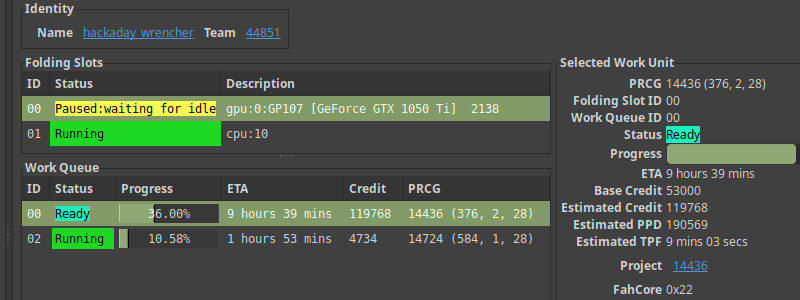The Hackaday community has answered the call and put their computers put to work folding proteins found in the coronavirus. Team_Hack-a-Day ranks #44 in the world so far this month, and I’ve seen us rank as high as #19 on 24-hour leaderboards.
Want to join the fight? Donate some of those computing cycles you’re not using to battling SARS‑CoV‑2. You’re probably not an epidemiologist or a vaccine researcher, but you can make their jobs easier by providing them with the data they need through the Folding@home Project.
As Dan Maloney explained in his excellent article on protein folding, understanding the incredibly complex folding behavior of the proteins in the virus will be key to finding treatments and possibly a vaccine. Folding@home connects countless computers via the internet and is now the largest supercomputer in the world, consisting of over 3.5 million CPUs and over half a million GPUs. The resulting data is freely available to researchers.
Let’s take a look at how easy it is to get up and running, how a GPU can supercharge a setup, and dip into the stats for Team_Hack-a-Day’s effort.
Setup is Simple
Your computer can be up and folding in ten minutes:
- Installation Guides
- There are also alternate download locations available
- Choose any alias you’d like to use for publicly displayed leaderboard
- Use team number 44851
- Optional: set up your own passkey
That’s it! But you’ll get more bang for your processing buck if you have a powerful video card in the mix. I finally got my own GPU running on the system and it quintupled my impact.
A Somewhat Dubious Guide to Linux GPU Setup
I have an Nvidia GeForce GTX 1050 Ti video card and I don’t game on this machine (unless you count Minecraft) so I might as well put it to good use folding proteins! Unfortunately, I couldn’t find a guide and the setup took me a while to work out. Hopefully by documenting my experience I can help others get their systems up and running a bit faster.
Folding@home can use GPUs via open OpenCL or CUDA (Nvidia cards only). I didn’t know exactly which packages I needed so I just installed them all. That’s why I call this a dubious install guide, you might not need all of these packages — for me, this install took about 1.5 GB of additional disk space. One note, I already had nvidia-driver-435 installed and used this command for the rest:
sudo apt install
ocl-icd-libopencl1
ocl-icd-opencl-dev
ocl-icd-dev
nvidia-opencl-dev
nvidia-cuda-toolkit
I restarted the Folding@home client: sudo /etc/init.d/FAHClient restart. However, this didn’t enable the ability to add a GPU in the Configuration–>Slots menu. I first needed to edit the configuration file itself and change the “gpu” value to true:
<!-- Folding Slot Configuration --> <gpu v='true'/> <!-- If true, attempt to autoconfigure GPUs -->
I once again restarted the client, then enabled the GPU using the add …read more
Source:: Hackaday

